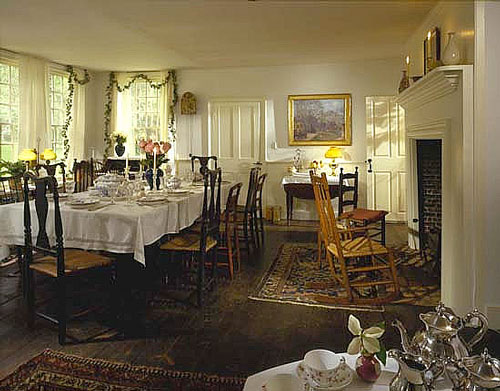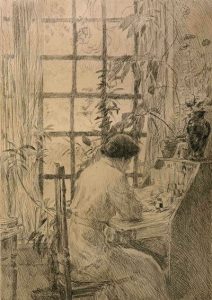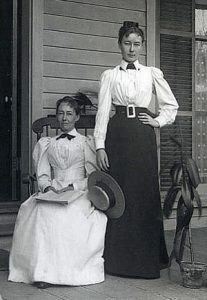“I tell you what, there is a lot do, but just keep their bellies full & their tongues wagging and you're all right. Every one is happy & thinks he is having a good time.”
Constant Holley MacRae to her mother, Josephine Holley, 1902
Click edit button to change this text. Lorem ipsum dolor sit amet, consectetur adipiscing elit. Ut elit tellus, luctus nec ullamcorper mattis, pulvinar dapibus leo.

The Holley House was known as a place of gracious hospitality. Nowhere is this more apparent than in the dining room, where guests and family gathered for meals each day. Art colonists, their spouses, the Holley’s and MacRae’s, and invited guests gathered around the long table to share their experiences and ideas, an important aspect of art colony life. Meals were served family style, orchestrated by Josephine Holley and Constant Holley MacRae, and executed with the help of hired servants. A vegetable garden, fruit orchard and chicken coop enticed the boarders, many of whom were accustomed to city life. Flowers from the gardens surrounding the house completed the romantic feel of the room. The result was an attractive combination of lively conversation and home-style meals in an elegant but comfortable setting.
Those who visited the art colony took part in Halloween parties, Japanese tea ceremonies, tableaux, boating, and piano playing. But it was around the dining room table that the liveliest conversations took place. Boarders, artists, journalists, writers, and others gathered here to debate current events and art. Many notables visited the art colony, including Lincoln Steffens, a muckraker journalist famous for uncovering government corruption, Willa Cather, an influential American novelist, and the publishers of The New Republic, are just of a few of the varied thinkers who participated in the art colony.

Women were considered second-class citizens at the turn of the century, yet they participated in American society in multiple ways, including operating boarding houses. Josephine Holley, and later her daughter Emma Constant Holley, were responsible for the domestic and business economy of the house. Positioned in the dining room, the women often used this writing desk to tend to numerous tasks, including purchasing ice, paying bills, hiring servants, and coordinating dinners.

Yet the women of the Cos Cob art colony ventured beyond the sphere of domesticity. Several women participated in the art colony by taking classes, organizing exhibitions, and producing their own artwork. The MacRae twins, Clarissa and Constant were active members of the Junior Suffrage Corps in Greenwich. As the art colony declined in the 1920s, women were achieving new levels of participation in American society and would gain the right to vote in 1920.
The Holley family employed African American servants, which they recruited from social service firms in New York City, such as the New York Colored Mission Employment Office. Issues related to race dominated American society during the late nineteenth and early twentieth century as the nation negotiated the affects of the Civil War, Reconstruction, the period following the war, and the on-going unease associated with mass immigration. African Americans struggled against limits placed on their social mobility and often continued in positions related to what they had done in slavery, including farm work and domestic service.

